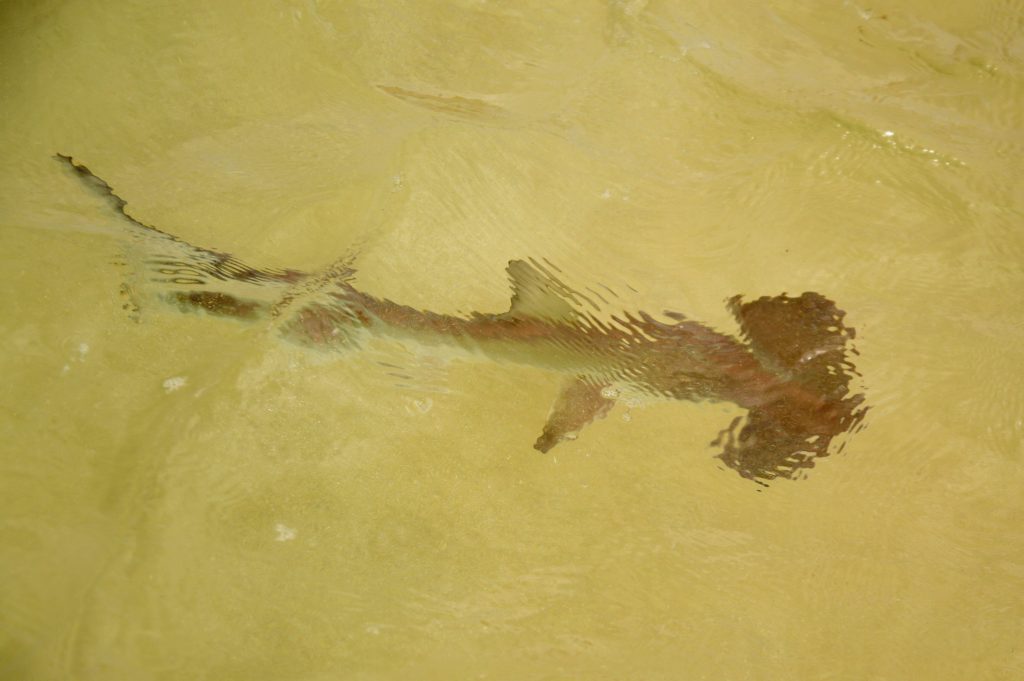
As with all fish, sharks also start out small…sometimes, very small. The world’s largest fish, the whale shark historically known to reach up to 20m (66ft) has young that on average measure 40-55cm long (1.5ft) when born. And although mysteries still surround where whale sharks are pupped and grow up when small, the birthing and growing out sites for many other species of sharks and rays, collectively known as elasmobranchs, are becoming increasingly known.
Our work focuses not only on threatened marine fauna but also their critical habitats and, for sharks, one of those habitats is a shark nursery.* These are sites where sharks are pupped (born) and spend the first months or years of their lives growing in an area that is relatively protected until they are large enough to avoid most predators, as sharks and rays do not benefit from any parental care.
You might think these areas are hidden and remote, but sometimes they are literally found under your nose. This is the case with Sal Rei Bay in Boa Vista, the easternmost island in the archipelago of Cabo Verde, West Africa.

Over the past two years, our team determined through visual censuses, fishing surveys and underwater camera trapping that Sal Rei Bay provides the ideal nursery area for a host of invertebrates, finfish and particularly sharks. Indeed, few shark nurseries had previously been identified in West Africa making this find regionally important. Sal Rei Bay is teeming with neonate (recently born) Blacktips (Carcharhinus limbatus), Milk Sharks (Rhizoprionodon acutus), the endemic Atlantic Weasel Sharks (Paragaleus pectoralis), and even the endangered and highly migratory Scalloped Hammerheads (Sphyrna lewini). To date, we have identified a total of eight species of juvenile sharks that kindly share this small bay with tourists and the people of Sal Rei.
Shark populations are extremely vulnerable to fishing due to their small number of offspring following long gestation periods – for Hammerheads it is 10 months, Blacktips around 11 months, and Milk Sharks a full year. As Sal Rei town continues to encroach on the bay, more sharks, including baby sharks, are frequently caught by recreational and artisanal (traditional/subsistence) fishers. Endangered Hammerheads are especially vulnerable despite being nationally protected, due to their rapid mortality when on the line or when entangled in nets.

To catalyze the conservation of these threatened species, our team of marine biologists is working hand in hand with the island’s fishers and the newly-formed fisher cooperative to identify, characterize and protect shark nurseries, to ensure the best start in life for these juvenile sharks. This research and conservation focus on shark nurseries is highlighted by leading shark scientists and the United Nations Food and Agriculture Organization as an effective means of improving shark survival.
Local government is increasingly taking an interest in safeguarding the bay as pressures mount from increased tourism to Boa Vista, further leading to a rise in fishing effort and greater recreational use of the bay. The close proximity of the bay to the island’s capital is also a great opportunity for experiential learning: Hammerheads are fast becoming an icon for our outreach and educational program geared at teaching local students about marine life and research and the importance of conservation through practical learning – including taking them out snorkeling in the bay with the small juvenile sharks.
Based on our field work and discussions with fishers, we believe Boa Vista may host several important elasmobranch nurseries. Given their significance for regional shark conservation, protecting these sites is a priority. Continued efforts are needed to ensure the issue stays high on the agenda of all stakeholders involved and the people of Sal Rei champion the bay’s young sharks. What can you do to help sharks when they are most vulnerable? Consider supporting our education and outreach efforts or volunteering to help with the research and monitoring of the shark nursery sites.

*A site is considered a nursery area for sharks if it has the following characteristics: (1) sharks are more commonly encountered in the area than other areas; (2) sharks have a tendency to remain or return for extended periods; and (3) the area or habitat is repeatedly used across years.



